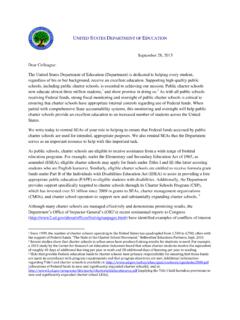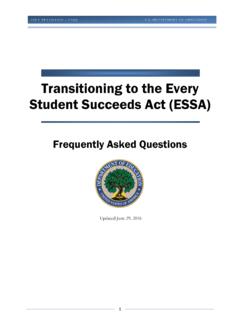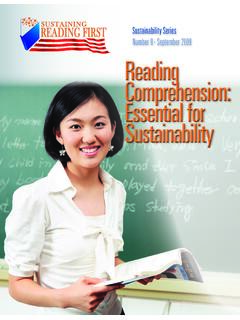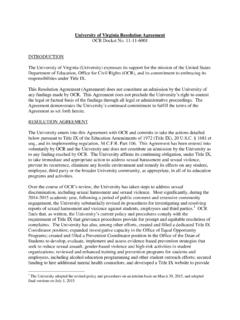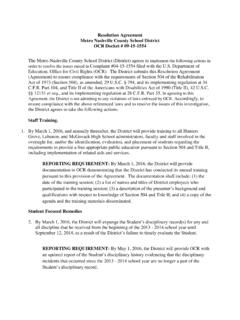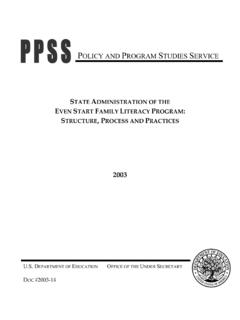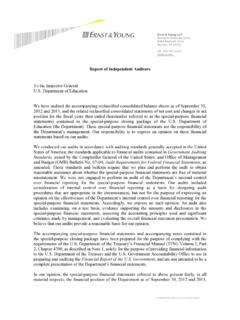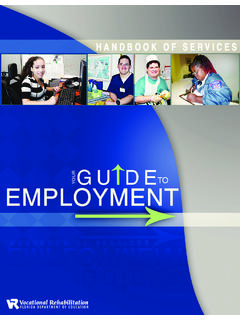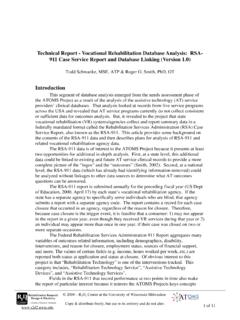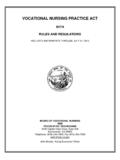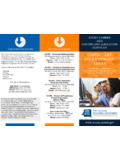Transcription of Archived: Special Projects and Demonstrations for ...
1 Chapter 325-1 Special Projects and Demonstrationsfor providing vocational RehabilitationServices to individuals with Disabilities(CFDA No. )I. LegislationThe rehabilitation Act of 1973, 93-112, Title III, Part B, Section 311 (a)-(d), as amended by and 103-73 (29 777a (a)-(d)); Title VIII, Section 802 (g) (29 797a (g))(expires September 30, 1997).II. Funding HistoryFiscal YearAppropriationFiscal YearAppropriation1974$1,000,0001988$26,1 10,000 4/19751,295,0001989 26,720,000 4/19809,568,0001990 42,145,000 5/19819,765,0001991 28,391,000 6/19828,846,0001992 41,526,000 7/19839,259,0001993 30,558,000 8/1984 11,235,000 1/1994 30,558,0001985 18,995,000 1/1995 30,558,000 9/1986 27,945,000 2/1996 24,941,000 9/1987 24,860,000 3/1/ Includes funding for the Spinal Cord Injury Program administered by the National Institute onDisability and rehabilitation Research (NIDRR).2/ Includes $5,000,000 for the Spinal Cord Injury Program, $718,000 for the South CarolinaComprehensive rehabilitation Center, and $4,785,000 for the Oregon Hearing Includes $5,000,000 for the Spinal Cord Injury Program, and $450,000 for Model StatewideTransitional Planning services for Severely Handicapped Youth Includes $5,000,000 for the Spinal Cord Injury Program and $475,000 for Model Includes $5 million for the Spinal Cord Injury Program, and $14,814,000 earmarked to establishComprehensive Head Injury Includes $5 million for the Spinal Cord Injury Program administered by the National Institute onDisability and rehabilitation Research (NIDRR).
2 7/ Includes $6 million earmarked for a Hearing Research Center, and $5 million for the Spinal CordInjury 325-2 This project is jointly funded under the rehabilitation Act, the individuals with Disabilities1 Education Act and the Carl D. Perkins vocational and Applied Technology In FY 1993, the Spinal Cord Injury Program was transferred to the National Institute on Disabilityand rehabilitation Amounts for 1995 and 1996 include appropriations for Supported Employment Projects , a separateactivity prior to FY Analysis of Program Performance A. Goals and ObjectivesThe goal of Special Projects and Demonstrations for providing vocational services to individuals withDisabilities is to develop innovative methods and comprehensive service programs to help individualswith disabilities achieve satisfactory vocational outcomes. These programs use a variety of approachesto improve vocational outcomes including supported employment, transitional planning, and increasedopportunities for consumer choice and develop innovative methods of serving unserved andunderserved populations.
3 These current-funded programs make discretionary awards on a competitivebasis to public and nonprofit community rehabilitation programs, designated state units, and public orprivate is expected that successful project results will be disseminated and replicated, in whole or in part, toresolve or alleviate rehabilitation problems that are nationally significant or common to several Strategies to Achieve the GoalsServices SupportedIn FY 1996, a total of 107 Projects --74 continuation Projects and 33 new Projects --were funded underthe Special Demonstrations Program. Among the continuation Projects funded in FY 1996 wereConsumer Choice demonstration Projects (7 Projects ), Transitional rehabilitation services for Youthwith Serious Emotional Disturbance and Serious Mental Illness (9 Projects ), Community-BasedSupported Employment (SE) Projects (18 Projects ), Statewide SE demonstration Projects (10projects), and SE Projects for individuals Who Are Deaf and Low-Functioning (3 Projects ).
4 Theprogram also continued support to 18 field-initiated demonstration FY 1996, the program also funded 15 new Projects to support the transition of youth with disabilitiesand 15 new field-initiated demonstration Projects . In addition, FY 1996 was the first year the SpecialDemonstrations program contributed to the jointly funded School-to-Work Technical Assistanceproject, aimed at improving the access of individuals with disabilities to appropriate transition1programs and School-to-Work Opportunities systems. At Congress direction, the SpecialDemonstrations Program also provided assistance to enable two previously funded regional head injurycenters to continue serving as national resource centers to help states improve services to survivors oftraumatic brain Program Performance Indicators of Impact and EffectivenessChapter 325-3 RSA has gathered limited performance information on community-based supported employmentprojects, which are required to provide annual performance information.
5 Data reported by 14community-based Projects show that in their first two years of funding (FY 1992 and 1993), 573persons were placed in competitive employment with an average hourly wage of $ RSA expectsthat the national supported employment project will build on the experience of the community-basedprojects by promoting the nationwide dissemination and replication of exemplary supportedemployment models and performance information is also available for the seven choice demonstration projectsauthorized under Title VIII. In FY 1993, the Department funded a contract to monitor and assist in theimplementation of the choice demonstration Projects . This contractor provided technical assistance toprojects, established a uniform data reporting system, documented problems encountered duringimplementation, and assessed each project s progress. As of July 31, 1995 (22 months into the projectperiod), these Projects had accepted 1,105 persons for service. Of these, 104 had their cases closedbecause they found employment, and 238 were placed in evidence from Projects funded under Sections 311(a) and (b) suggests that certain projectshave been successful in demonstrating rehabilitation methods that are disseminated and replicated oradapted by other service providers.
6 For example, one project developed innovative approaches to thetransition of young adults with severe disabilities. In addition to placing and maintaining inemployment approximately 60 individuals with disabilities, the project has created and disseminatedtraining materials and provided technical assistance to Projects nationwide on the natural support approach to the transition of individuals with disabilities. (Natural support is support that is provided toan individual with a disability in the workplace by employers, co-workers, or other persons who are notpaid service professionals.)IV. Planned StudiesIn accordance with the statutory requirement that the Department conduct an evaluation of the choicedemonstration Projects , the Department recently engaged a contractor to determine the effectiveness ofthe choice approach in improving rehabilitation processes and outcomes. The contractor will followthe Projects for the duration of their funding. Results of this evaluation are expected in March Sources of Information1.
7 Program of Special rehabilitation Projects and Demonstrations for Severely DisabledIndividuals: Final Report (Winchester, MA: Harold Russell Associates, Inc., February 1987). Control Review: Special Projects and Demonstrations for providing VocationalRehabilitation services to individuals with Severe Handicaps: Final Report (Washington, DC: of Education, March 1991).Chapter 325-4VI. Contacts for Further InformationProgram Operations:Thomas E. Finch, (202) 205-9796 Program Studies:Michael Fong, (202) 401-3630
